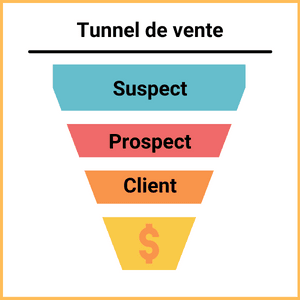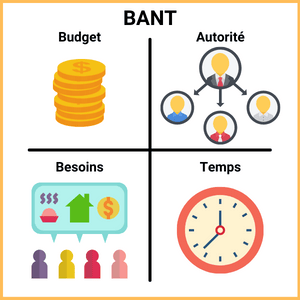Customer care is the key to building a relationship of trust with your customer. Your objective? That they remain loyal to your brand/company, recommend you and continue to be a customer.
By taking the time to identify and research your customers’ needs, you’re much more likely to convert the people most likely to buy from you. How to boost your sales follow-up with the right sales follow-up software.
Define your sales funnel / tunnel
It’s called a funnel because of the shape it takes at each stage. At each stage, the number of visitors will decrease, because not all prospects will convert. It will define the path that will enable you to turn a suspect into a customer.
It’s up to you to determine the stages your prospects need to go through in order to become customers. This will enable you to identify sticking points and show you that the majority of prospects stop at certain stages. You can then improve this part of your sales process to convert more prospects.

For example, at Moovago we have divided our sales tunnel into several stages:
1. We attract prospects through advertising and free content on the Internet and on Linkedin.
2. These prospects use our site to find relevant information.
3. Some of them are interested in our application.
4. They try the Moovago application.
5. They become users of the Moovago application.
6. They become Moovago ambassadors and tell their friends and family.
7. We carry out regular checks to understand the new needs of current customers.
These stages will be very different depending on your company’s field of activity and goals. Once you’ve done this, you’ll be able to classify your prospects according to the stage they’re in, so you can better follow up with your customers and analyze any blockages.
Once your prospects have become customers, you can also create recurring tasks so that you can call them to find out how things are going, and if they need any new products or services. New requests from existing customers can be tracked using business tracking or quotation tracking.
It’s important to identify and understand the new demands of existing customers, so that they don’t go away. An existing customer is much easier to keep than a new one is to convince.
Use the right customer care software
Many types of company in a wide range of sectors have difficulty keeping track of their prospects and customers, or are growing so fast that their customer follow-up suffers. Others have no clear, defined way of tracking sales. Both new and established businesses can face these problems.
Customer tracking software can be the solution to these and other challenges. If your business needs to build better relationships with prospects, manage lead interactions and improve sales, you’ll benefit from customer tracking software.
These programs are also known as CRM software.
Please note that not all CRM software is suited to your needs.
At Moovago, we’ve developed a software/application specialized in customer follow-up for traveling sales representatives.
You’ll be able to create and optimize routes (i.e. rounds) directly in your customer tracking application, available on web, mobile and tablet. Find all the essential tools used by sales reps: reports, reminders, reminders, tasks, appointments and sales revenue.
Thanks to reminders, you’ll know which companies to visit, and you can also choose your route according to sales revenue opportunities.
You can also discover other software of this type on this article: CRM software examples
Qualify your prospects
The BANT method, and more recently the GPCTBA/C&I method, can be used to qualify your potential customers. This means you’ll give priority to working with certain prospects over others, because they’re more likely to become your customers, thus prioritizing your customer follow-up.
BANT method :
The BANT method is used to prioritize the management of your prospects according to 4 criteria:
Budget: Can your prospect afford your product or service? Even if you’re the best salesman in the world, you’ll have a hard time selling a private jet to the average person. So don’t waste time on prospects who can’t or won’t pay the price for your products.
Authority: Does your prospect have the authority to make the decision to buy the product? If your prospect is a trainee, or if he’s the company director, this will change a lot of things for you. You need to focus your time on the prospect who can choose to buy your product or service.
Need: What are your prospect’s needs? To do this, you need to get in touch with the prospect and really understand their needs, so you can offer them an experience that’s tailor-made for them. If you can’t meet the prospect’s needs, stop wasting time conversing with them.
Time When does the prospect need the product or service? If your prospect needs your product several years from now, then you can focus on the prospect who needs it now.
The more a prospect meets your requirements, the more you need to prioritize them. Generally speaking, a good prospect meets 3 of the 4 conditions.


